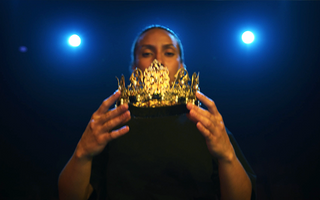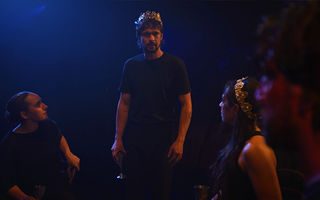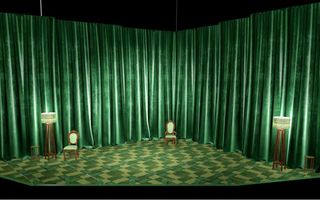 Watch
Watch
Macbeth is Shakespeare’s shortest tragedy. It was written in the early 17th century, not long after King James I was crowned after the death of Queen Elizabeth I.
James was a great patron of the theatre. Soon after his coronation he gave Shakespeare’s company the title of ‘The King’s Men’ and commanded that they play regularly at court, where this play was almost certainly seen around 1606. The earliest surviving definitive account of the play is from an audience member called Simon Forman who attended a performance at the Globe Theatre in 1611. The play was hugely popular during its time and was a particular favourite of diarist Samuel Pepys who is recorded to have seen six productions of the show in 1667 alone. On April 19 of that year he wrote that Macbeth is, ‘one of the best plays for the stage that I ever saw’.
King James I had been King James VI of Scotland for 37 years before he succeeded to the English throne. He was a superstitious and paranoid king who greatly feared the art of witchcraft. In 1597 he wrote a political and theological publication on the subject called Daemonologie that justified the persecution of witches in a Christian society under the rule of canonical law. The book included a news pamphlet that gave details of the North Berwick Witch trials that took place in Scotland. The witches involved in the trial are believed to have confessed to using witchcraft to raise a tempest to sabotage James I’s ship when he and his Queen were sailing from Denmark to Scotland. It is believed that Shakespeare may have been referencing this in Macbeth through the witches’ lines, “Though his bark cannot be lost, yet it shall be tempest tossed” (Act 1, Scene 3). When Macbeth was written, women all over Europe were still being executed as witches, so the power displayed by Shakespeare’s witches or Weird Sisters would have been considered, by much of the Jacobean population, as completely plausible. Similarly, most people in the 17th century still believed in ghosts, so Banquo’s appearance at the banquet table would have been assumed to be a genuine apparition, not just a sign of Macbeth’s deteriorating mental state, as we often reappropriate it today.
The Weird Sisters also form part of a series of references in the play to the Gunpowder Plot of 1605, in which Catholic dissidents planned to assassinate King James, his son, and the entire government in one explosion at the Houses of Parliament. The plot was discovered, and the assailants were brought to trial, during which the king carefully organised the public’s outrage, including inventing Guy Fawkes Day (Gunpowder Treason Day as it was then known). A dissidents’ act was then passed and linked to witchcraft, and several plays were written around 1606 and 1607 referring to the conspiracy. It is no surprise that after this event James I was not a fan of regicide (the murder of a king) being depicted on stage. As Shakespeare’s Macbeth so clearly references this event, and carefully offers a warning to those attempting such a treasonous act, historians often use The Gunpowder Plot as a way to date Shakespeare’s play.
James was also very insistent on the ‘divine right of kings’, and the ‘great chain of being’, which is the belief that the king is appointed by God and that any act against him is not only treachery but the worst kind of mortal sin. It was a common renaissance belief that the honour and rightful seating of the monarch directly affected nature and the well-being of the state. If the throne was usurped or unlawfully won, it not only placed the nation in great danger but manifested itself in such things as poor harvests and ominous weather. James I was highly preoccupied with this worldview and Shakespeare very much plays on this in Macbeth.
One of the ways the Weird Sisters trick Macbeth is by encouraging him to fear being succeeded by the children or heirs of Banquo. In fact, the Weird Sisters’ prophecy is a reference to King James’ family claim to have descended from the (possibly mythical) Banquo, Thane of Lochaber, a family line that did not come into play for several generations after Malcolm replaced Macbeth. Macbeth would have gained nothing even if he had succeeded in having Fleance killed, and this makes his efforts as ironic as his dismissal of the seemingly impossible prophecies that then came to pass. It is important to note that at this time the law of Tanistry governed the royal succession in Scotland: a king was succeeded not by his eldest son but by the most respected of his kinsmen. This of course justifies Macbeth’s relationship to the crown in the play, first coveting it as something he could achieve and then later holding the honoured position.
The Historic Record
Macbeth, Duncan and Malcolm are real figures from Scottish history. Shakespeare sourced and adapted their stories from the historian Raphael Holinshed’s Chronicles, specifically his Historie Of Scotland. Shakespeare didn’t appear to care much for historic accuracy in his plays – he seems to have been more interested in using history as source material for a good story. However, Shakespeare still had to be careful about how he presented royal family history in relation to the current reigning monarch. James I was from Scotland and believed he was a direct descendant of Banquo. For this reason, Shakespeare ensures that his Banquo has no involvement in the murder of Duncan, although according to history he was a co-conspirator and is labelled as much in Holinshed’s Chronicles. In reality Duncan was young and weak, not old and wise, and Macbeth ruled successfully for 17 years before being deposed and slain. The Scottish royal line of succession shows that Macbeth’s main claim to the throne was through his wife, Gruoch, who, like Duncan, was descended from Malcolm I. Oddly enough, you can see that Queen Gruoch had a son by her first husband, so perhaps her line that she knows “how tender ’tis to love the babe that milks me” (Act 1, Scene 7) and Macduff’s “He has no children” (Act 4, Scene 3) are not such a puzzle after all.










